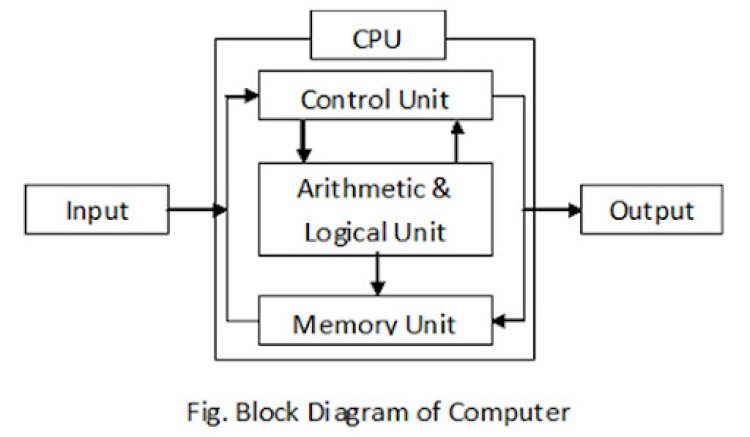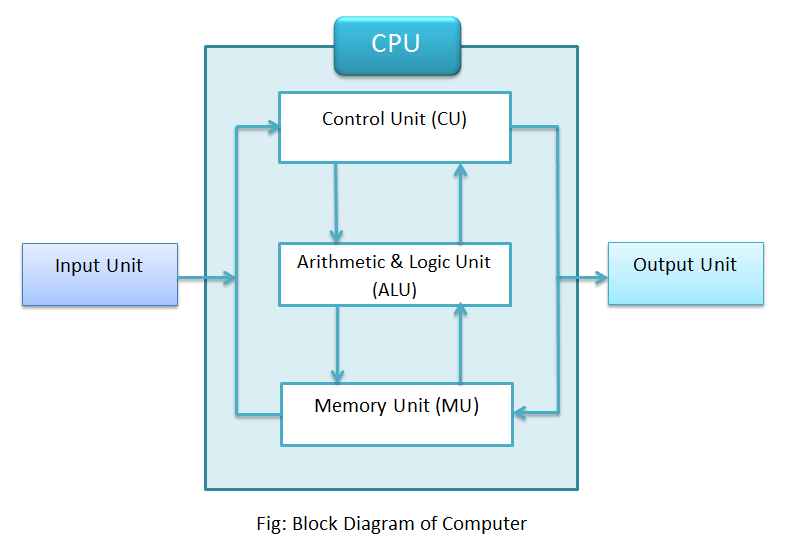Draw and Explain The Block Diagram of Computer System.
Here is the explanation of the block diagram of a computer system along with its various components.

With the rapid development of technology, computers have become a part of our daily life.
From basic operations such as watching movies to advanced functions such as making cars. All of this is done on your computer.
But have you ever wondered how a computer works? What process is going on in it? What are the basics of a computer? Computers, like any other machine, have a basic architecture. It consists of several elements. These elements process the input and produce the desired result. Let's take a look at the basic block diagram of the computer. Then you will understand how each part contributes to its function.

Input
All data entering the computer passes through the input device. Input blocks are made up of different devices. Devices such as mice, keyboards, scanners, etc. In other words, each of these devices acts as an intermediary between you and your computer.
Data to be processed passes through input block. Computers accept raw data in binary format. It then processes the data and produces the desired output.
The three main functions of the input block are:
- Receive data for processing by the user.
- Converts data into a machine-readable format.
-
It then transfers the converted data to the computer's main memory. Its sole purpose is to connect you and your computer. Also, it allows for easy communication between them.
CPU - Central Processing Unit
The central processing unit, or CPU, is the brain of a computer. It works in the same way as the human brain. Just as the brain controls all human activities, the CPU controls all tasks.
The central processing unit also performs all arithmetic and logical operations on the computer. The CPU now consists of two blocks: the Arithmetic Logic Block (ALU) and the Control Block (CU). These two devices work in sync. The CPU processes the data as a whole.
ALU - Arithmetic Logic Unit
Arithmetic logic units consist of two terms: arithmetic and logic. This device has two main features.
Data is inserted into main memory via input block. Perform basic arithmetic operations. Like addition, subtraction, multiplication, and division. It performs all kinds of calculations necessary for your data. It then sends the data back to storage. Blocks also perform logical operations such as AND, OR, equal to, less than, etc.
In addition to this, it performs concatenation, sorting and selection of given data.
CU - Control Unit
As the name suggests, the control unit is the controller of all tasks/tasks and tasks. All of this is done inside your computer. The memory block sends a set of commands to the control unit. The control unit then translates these commands in turn. These commands are converted into control signals.
These control signals help prioritize and plan tasks. Thus, the control unit coordinates tasks within the computer in synchronization with input and output devices.
Memory Unit
All data that needs to be processed or processed is stored in a block of memory. The memory block acts as a hub for all data. Transfer to the right side of your computer when needed.
memory blocks work in sync with the CPU. This helps to speed up data access and processing. This makes the job easier and faster. There are two types of
computer memory.
Primary Memory -
This type of memory cannot store large amounts of data. Therefore, it is only used to store up-to-date data. Stored data is temporary. It can be erased after power off. Therefore, it is also called temporary memory or main memory.
RAM stands for Random Access Memory. This is an example of basic storage. This memory is directly accessible from the CPU. Used for reading and writing. To process data, it must first be transferred to RAM and then transferred to the CPU.
Secondary memory -
As described above, primary memory stores temporary data. Therefore, you will not be able to access it in the future. Secondary memory is used for persistent storage. It is also called permanent memory or auxiliary memory. A hard drive is an example of a secondary storage device. Even if there is a power outage, data is not easily erased.
Output
It's not surprising what the output block is used for. Any information sent to the computer after processing is received by the user via an output device. Below the output block are devices such as printers, monitors, projectors, etc.
The output block presents data in the form of electronic or paper copies. Printer for paper copying. The monitor is for display purposes only. The output block receives data from the computer in binary format. It then converts it to a human-readable format.
block diagram of computer, computer block diagram, block diagram of computer system, explain block diagram of computer, draw the block diagram of computer, explain the block diagram of computer, simple block diagram of computer, computer diagram, draw a block diagram of computer, diagram of computer, draw and explain block diagram of computer, draw and explain the block diagram of computer, block diagram of cpu, draw block diagram of computer, block diagram of a computer, draw the block diagram of computer system, draw a block diagram of a computer system, computer ka block diagram, draw block diagram of computer and label it, basic block diagram of computer, draw block diagram of computer system, simple computer diagram, cpu block diagram, explain block diagram of computer system, draw a block diagram of computer system, what is block diagram of computer, block diagram of computer with explanation, explain the block diagram of a computer, block diagram of computer explain, block diagram of computer and explain, basic computer diagram, block structure of computer, internal diagram of computer system, diagram of computer system, block diagram in computer, block diagram of computer system with explanation, functional block diagram of computer, block diagram of computer and explain its components, parts of computer diagram, components of computer with block diagram, block diagram of computer and its components, explain block diagram of computer in detail, working of computer with diagram, draw the block diagram of a computer system, block diagram of computer architecture, explain the block diagram of computer system, labeled diagram of computer, pc block diagram, diagram of computer memory, computer ka diagram, explain the block diagram of computer in details, draw a block diagram of cpu, computer process diagram, block diagram computer, draw the block diagram of cpu, block diagram of computer memory, draw block diagram of computer and explain its components, block diagram of computer organization, diagram computer, block diagram of computer and explain its various parts, computer basic diagram, explain the block diagram of computer in detail, block daigram of computer, black diagram of computer, what is computer with diagram, what is the block diagram of computer, explain block diagram of a computer, blog diagram of computer, explanation of block diagram of computer, working of computer diagram, what is computer explain the block diagram of computer, define block diagram of computer, block digram of cpu, computer system block diagram, block diagram of computer organisation, block diagram of computers, make a block diagram of computer, functional diagram of computer, digram of computer, what is computer explain with diagram, basic block diagram of computer system, block diagram of computer and explain its various parts pdf, block diagram of cpu and explain, diagram of computer and its parts, computer digram, block digram of computer, block of computer







